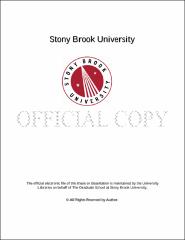| dc.identifier.uri | http://hdl.handle.net/11401/77687 | |
| dc.description.sponsorship | This work is sponsored by the Stony Brook University Graduate School in compliance with the requirements for completion of degree. | en_US |
| dc.format | Monograph | |
| dc.format.medium | Electronic Resource | en_US |
| dc.language.iso | en_US | |
| dc.publisher | The Graduate School, Stony Brook University: Stony Brook, NY. | |
| dc.type | Dissertation | |
| dcterms.abstract | This thesis presents a comparative study of textile tools and textile remains from the Iron Age II (c. 1000 – 500 BCE) Levant as a means to investigate textile production and procurement in international economies. Earlier studies interpret the increase in loom weights (components of warp-weighted looms) during the Iron Age II as evidence that weavers working with these looms were the predominant source of textiles in the Levant. Yet there is no consensus on the nature of the textiles woven on warp-weighted looms, which authors independently describe as fine trade commodities, tapestries for tribute payments, and coarse fabrics for households and agricultural industries. This study builds on results of Martensson et al.’s (2009) experimental weaving to describe a new approach for reconstructing the textiles woven with Iron Age II warp-weighted looms from loom weights. These reconstructions are compared to textile remains and textile impressions in order to describe the variation in fabrics that could have been woven with warp-weighted looms. Applied to loom weights from twelve Iron Age II sites, this method shows that Levantine warp-weighted looms were best suited for weaving multiple types of animal fiber (i.e. wool and goat hair) textiles rather than fine bast fiber (i.e. linen and hemp) fabrics. This demonstrates that Iron Age II society had multiple strategies to produce and procure textiles, some of which may have been overlooked due to ubiquitous evidence for warp-weighted looms. | |
| dcterms.abstract | This thesis presents a comparative study of textile tools and textile remains from the Iron Age II (c. 1000 – 500 BCE) Levant as a means to investigate textile production and procurement in international economies. Earlier studies interpret the increase in loom weights (components of warp-weighted looms) during the Iron Age II as evidence that weavers working with these looms were the predominant source of textiles in the Levant. Yet there is no consensus on the nature of the textiles woven on warp-weighted looms, which authors independently describe as fine trade commodities, tapestries for tribute payments, and coarse fabrics for households and agricultural industries. This study builds on results of Martensson et al.’s (2009) experimental weaving to describe a new approach for reconstructing the textiles woven with Iron Age II warp-weighted looms from loom weights. These reconstructions are compared to textile remains and textile impressions in order to describe the variation in fabrics that could have been woven with warp-weighted looms. Applied to loom weights from twelve Iron Age II sites, this method shows that Levantine warp-weighted looms were best suited for weaving multiple types of animal fiber (i.e. wool and goat hair) textiles rather than fine bast fiber (i.e. linen and hemp) fabrics. This demonstrates that Iron Age II society had multiple strategies to produce and procure textiles, some of which may have been overlooked due to ubiquitous evidence for warp-weighted looms. | |
| dcterms.available | 2017-09-20T16:53:19Z | |
| dcterms.contributor | Shea, John | en_US |
| dcterms.contributor | Zimansky, Paul | en_US |
| dcterms.contributor | Twiss, Katheryn | en_US |
| dcterms.contributor | Hildebrand, Elisabeth | en_US |
| dcterms.contributor | Mazow, Laura. | en_US |
| dcterms.creator | Nelson, Thaddeus Nelson | |
| dcterms.dateAccepted | 2017-09-20T16:53:19Z | |
| dcterms.dateSubmitted | 2017-09-20T16:53:19Z | |
| dcterms.description | Department of Anthropology | en_US |
| dcterms.extent | 207 pg. | en_US |
| dcterms.format | Monograph | |
| dcterms.format | Application/PDF | en_US |
| dcterms.identifier | http://hdl.handle.net/11401/77687 | |
| dcterms.issued | 2016-12-01 | |
| dcterms.language | en_US | |
| dcterms.provenance | Made available in DSpace on 2017-09-20T16:53:19Z (GMT). No. of bitstreams: 1
Nelson_grad.sunysb_0771E_12868.pdf: 3591044 bytes, checksum: e6d56234b48b6c6eff1204a6cee6f6c8 (MD5)
Previous issue date: 1 | en |
| dcterms.publisher | The Graduate School, Stony Brook University: Stony Brook, NY. | |
| dcterms.subject | Archaeology -- Textile research | |
| dcterms.subject | Iron Age, Levant, Loom Weight, Textile, Warp-weighted Loom, Weaving | |
| dcterms.title | Artifactual Evidence for the Role of the Warp-Weighted Loom: The Transformation of Textile Production in the Iron Age Levant | |
| dcterms.type | Dissertation | |

